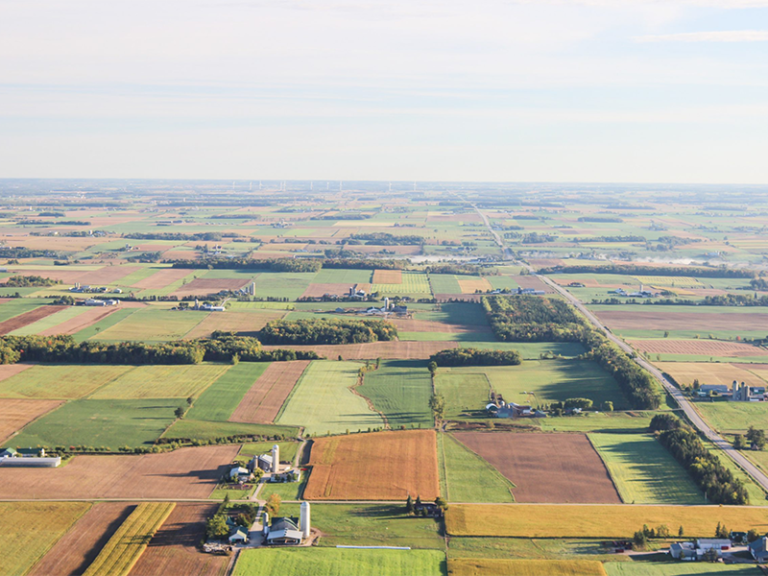First published: July 22, 2004
by Keith Oliver
This is the fourth in a series of articles about the process of planning for the growth and development of human settlements in general, and in particular, the 500 hectare northeast corner of Cobourg, presently known as Area C. 30 years from now, when Area C is fully developed, Cobourg will be twice its present size.
The barriers that dictate a linear urban form for Cobourg.
The third article in this series described the factors to be used in determining the future urban form of Cobourg and the importance of agreeing now on what that form should be. Based on incomplete background information, my best guess is that Cobourg should assume a linear urban form that expands to the west after Area C and the existing town have been fully and efficiently developed, and the seven proposed performance objectives for the whole town have been achieved.
The principle factors which determine that the best urban form for Cobourg include both natural and man-made barriers to growth. In the case of Cobourg these include Lake Ontario and the 401 highway. A major visible automobile transportation corridor with its super-human scale of movement, noise and wide right-of-way, creates both a functional and perceived division when it passes through a built urban community. For that reason the elevated highway through the City of Boston is being torn down and replaced at a cost of billions of dollars, and the same fate is being considered for the Gardner Expressway in Toronto.
Railroads provided the same kind of barrier in earlier times when steam engines burned dirty coal and crowded low-income housing was built on cheap land next to the railroad right-of-way. There was once a sigma attached to being from “the other side of the tracks”. You can still see it all in the built history that still exists next to railroads as you enter older cities by train. Today, because of better planning, cleaner means of locomotion, and the possibility that trains may one-day play a major role in solving our material and human transportation problems, our attitude toward railways has changed. A clean, high-speed train, running conveniently through the centre of Cobourg and offering a quick commute to work or entertainment in other urban centres, is considered a significant benefit to living in this town. It may also justify a new railway station in Area “C”.
The importance of the centre.
A second factor that will play a major role in the successful functioning of the future urban form of Cobourg, and have a direct impact on the quality-of-life experienced here, is the location and function of a centre of the larger community as well as smaller neighbourhood centres.
In town planning terms, the word “centre” refers to something that is much more than a geographical point on a map. In this case the word “centre” refers to the successful function of a public meeting place where disparate individuals from all social and income groups in the larger community are encouraged to come together in a spontaneous and frequent manner; where different ideas and interests converge and collide on a random basis; where public debate takes place and differing opinions are exchanged; where the community honours its past and present, and where all of the above contribute to the creation of a community of mutual respect, acceptance and shared beliefs.
To achieve this function a centre-of-the-community must contain the greatest possible variety of businesses, services and public amenities to provide a draw for the greatest variety of individuals. A simple rule for a town council, concerned with the success of its town centre is that it should use every means, both large and small, to maintain, encourage and increase that variety. Removing the baseball diamond from Victoria Park reduces that variety. Losing the Motor Vehicle Office from the Dressler House to the Mall in 2000 did the same, as well as reduce the number of individual visits to the downtown by 50,000 a year. Every village and town has its own unique culture, the extent and character of which is determined by by the success of its centre and by its history.
When a place of meeting is not a centre.
There are many meeting places in a town that do not function as a centre-of-the-community. A church, a service club, a school, a political organization, a yacht club, a ratepayer’s association, a model railroad club, all attract individuals who have particular special interests and where different kinds of discussion may be overtly or covertly discouraged.
Despite its outward appearance, a shopping mall is not a centre in the town planner’s true sense of the word. The modern shopping mall is a strictly controlled environment where the distribution of political or controversial literature is forbidden; where only businesses that have reached a certain level of success can afford the rent and true local businesses are seldom to be found; where single property ownership makes real competition for tenants nonexistent; and where doors can be locked and the public prevented from entering at the owner’s discretion. Putting pamphlets on cars in a mall parking area is an act that will summon mall security officers and cause one to be escorted from the property.
The fallacy that business alone is the means to success.
There is a fallacy that successful businesses alone indicate a successful centre for the community. A case in point is downtown Niagara-on-the-Lake where successful businesses abound and the streets are full of people. The problem is that the businesses are mostly expensive boutiques which do not serve the community as a whole, and the people on the streets are tourists, interested primarily in the Shaw Festival and the expensive shops, and not local residents. While the downtown is a source of local jobs and above-average property tax revenues for the town, it has no meaning as a centre-of-the-community. Niagara-on-the-Lake is a town without a centre.
The future of our historic centre of the community.
Downtown Cobourg is the only place in the town that fulfills the town planner’s definition of a centre-of-the-community. Despite ongoing losses it continues to have the greatest variety of businesses, services and public amenities, and in its built-heritage it is the most significant repository and daily reminder of our local history. Because of the competition for tenants between many property owners, the downtown offers the greatest variety of rental opportunities and is the best location in the town for the start-up of small businesses.
In our ever- changing world, and like anything else of value, a conscious effort must be made to maintain the central function of the downtown. For example, more could be done to increase the evening and weekend use of the bandshell, or to accommodate the needs of young people. Where once there was the Pavilion dance hall and roller-skating rink, and every drugstore had a soda bar where teens met and hang out together, now there is nothing. To balance the construction of high-end condominiums around the yacht basin and keep the harbour area public, the town should use the land it owns south of Albert Street to leverage the construction of rental housing and at least one residential coop. It should encourage all new buildings in the downtown to have commercial space on the ground floor and to be built close to the sidewalk, thereby enclosing the street and maintaining the unique human-scale of historic public spaces.
The relationship of the downtown centre to the Elgin/Strathy area.
What is now an indisputable part of this town is the growing concentration of retail businesses at its northwest corner, or the Elgin/Strathy retail area. While this area cannot function as a centre-of-the-community for the reasons given above, it is important that it be linked to the downtown by the most convenient means possible. If done so successfully, through the advertizing of downtown public events and retail sales, and the existence of a low cost bus service, the Elgin/Strathy retail area could become a virtual extension of the downtown centre. Underused parking at the mall could function as parking for those using the downtown. To do so may involve a reconsideration of the permitted land-use along both sides of William Street and the successful development of transit-supportive land-use throughout all of the town.
Does Area C justify a second town centre?
The draft Secondary Land-Use Plan for Area C proposes a mixed use Village Centre along both sides of Elgin, between Brook Road North and Greer Road. For a number of reasons there is a serious question as to whether or not this should happen.
Elgin Street East will be a well travelled east/west, four or five lane arterial road that could make crossing on foot in the Village Centre area unsafe and its scale of vehicle movement threatening to the point where its implied pedestrian-friendly character will be non-existent. To add to this Elgin in this area is a dead straight road on a pronounced incline rising to the east. In many respects it is a road more conducive to hot-car drag racing than to a Village Centre.
An even larger consideration is the topography of the entire site and the existence of a large environmentally important wetland and flood plain that divides Area C on a northeast to southwest axis and suggests that the entire site be developed with a strong southwesterly orientation to the existing town. This orientation for the south half of Area C, along with an east to west orientation along Elgin for the north half of the area, works perfectly in that it by-passes the Northam Industrial Park and connects to the downtown centre on one hand and the Elgin/Strathy retail area on the other. Both Elgin and the proposed Kerr Street extension are well placed to connect to the possible future growth of the town to the west.
Instead of trying to develop its own centre-of-the-community, which might contribute to the isolation of Area C from the rest of the town and weaken the function of the existing downtown centre, it may be better to conceive of Area C as an area characterized by extensive public open space and protected natural systems. In this case the urban form of the area could be that of a series of neighbourhoods with their own individual walkable neighbourhood centres, and without an attempt to develop a larger centre-of-the-community.
The fifth article in this series will deal with the concept of neighbourhood centres, and the benefits of transit-supportive planning and reduced automobile dependency.
Note: Part 4


